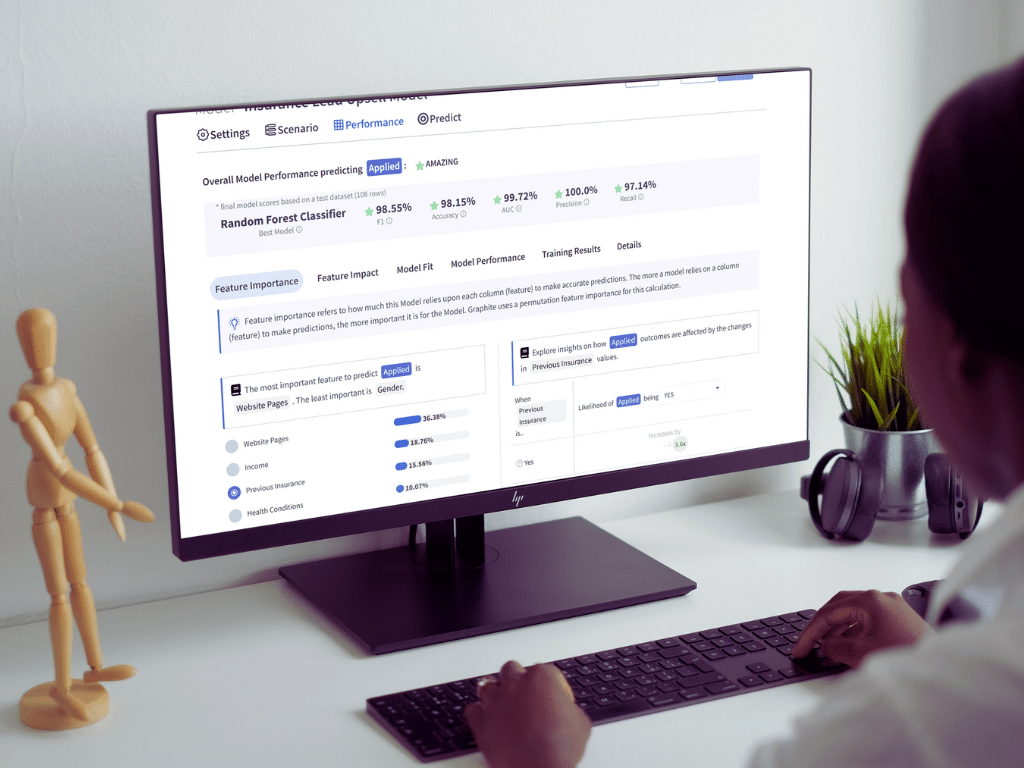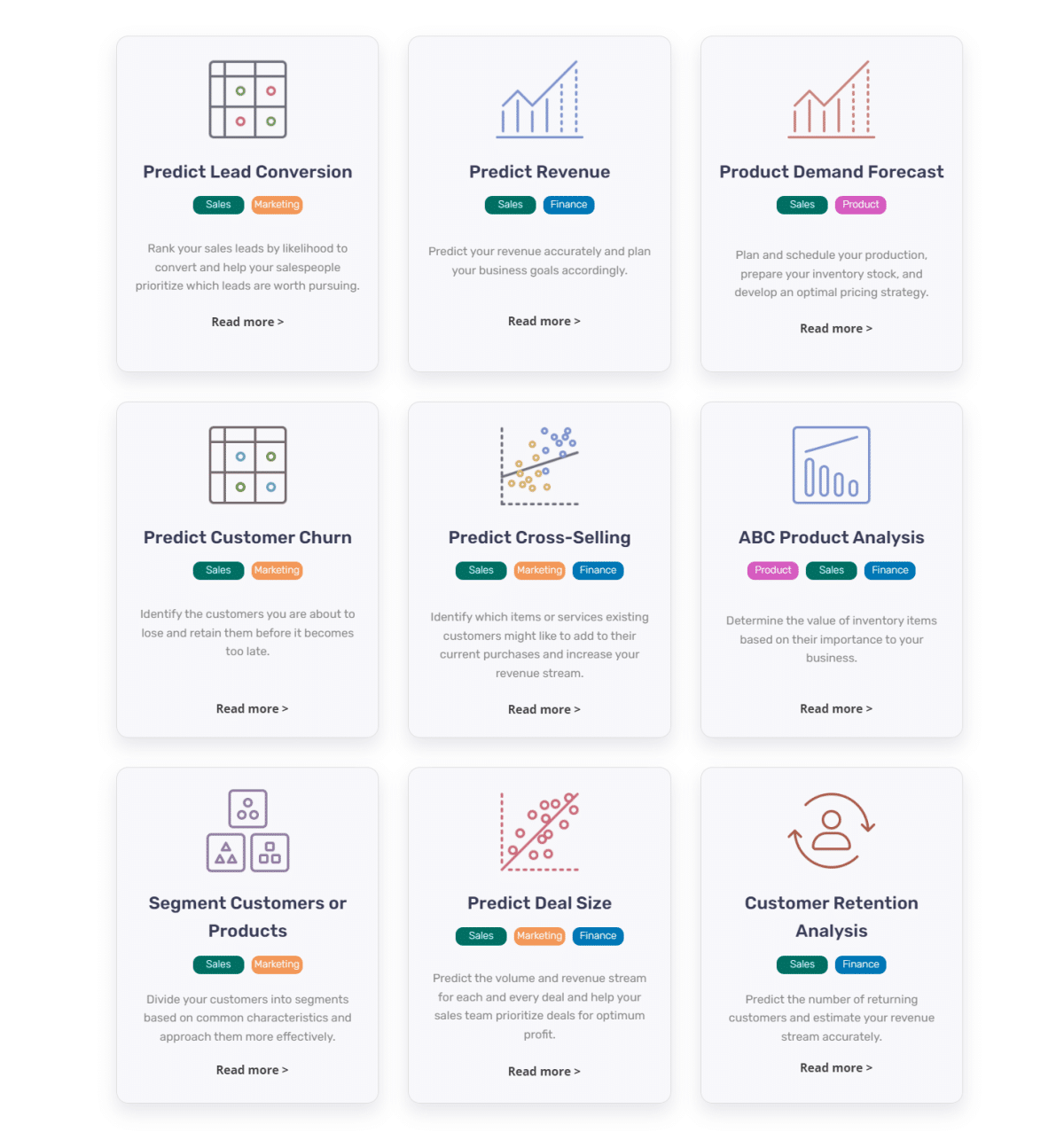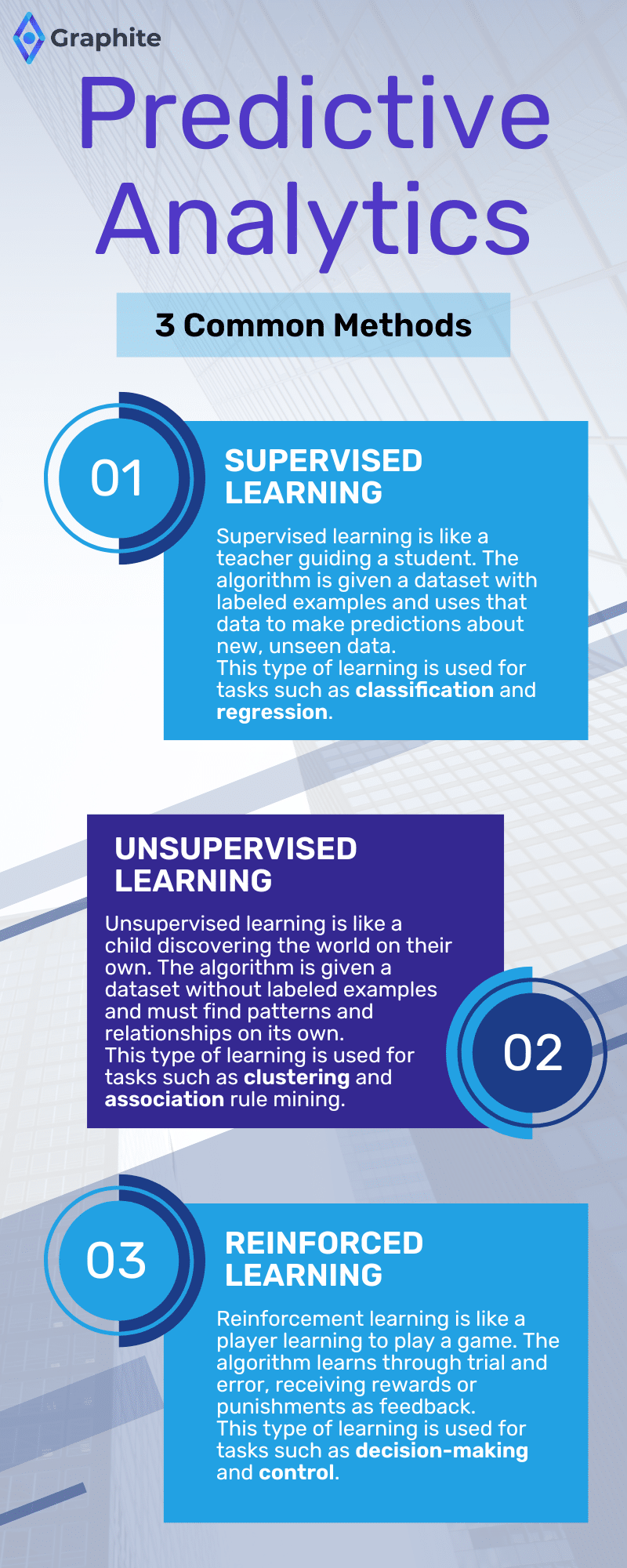Understanding Predictive Analytics for Business
Imagine you’re the ship’s captain, sailing in the vast ocean of data. You’re trying to navigate through the stormy waters of customer behavior, market trends, and sales predictions. But you need help to make sense of it all.
The good news is, you don’t have to do it alone.
Introducing predictive analytics – the compass that guides you through the data sea, helping you make informed decisions and chart a course for success.
- Understanding Predictive Analytics for Business
- What is Predictive Analytics and How Does it Work?
- A Step-by-Step Guide to Predictive Analytics: Understanding the Process
- Supervised, Unsupervised, and Reinforcement Learning: A Detailed Explanation for Non-technical Audiences
- A Look at Use Cases for Supervised, Unsupervised, and Reinforcement Learning
- Why Predictive Analytics is Essential for Business Success
- Exploring the Bright Future of Predictive Analytics and No-Code Tools
- Conclusion
This article is designed to take you on a journey of understanding predictive analytics. We’ll cover everything from the basics of what it is and how it works to the different types of predictive analytics, their use cases, and why it’s essential for business success.
With the help of predictive analytics, you’ll be able to predict future events, improve decision-making, and gain a competitive advantage. Let’s set sail and discover the power of predictive analytics together.

What is Predictive Analytics and How Does it Work?
Predictive analytics is like a crystal ball for your business. It allows you to peek into the future and make informed decisions based on what’s to come.
But what exactly is it?
Predictive analytics is a branch of data analysis that uses statistical techniques and machine learning algorithms to make predictions about future events. It’s all about using historical data to identify patterns and trends, and then using that information to make predictions about what will happen in the future.
Imagine you’re a retailer trying to predict which products will be popular next season. By analyzing sales data from past seasons, you can identify patterns and trends that can help you make an educated guess about what will sell well in the future.
But predictive analytics isn’t just for retailers. It can be used in a wide range of industries, including healthcare, finance, marketing, sales, operations, and manufacturing.
In healthcare, for example, predictive analytics can be used to identify patients at risk of developing certain conditions, while in finance, it can be used to predict which customers are most likely to default on a loan. In short, predictive analytics is a powerful tool that can help businesses of all types make better decisions and stay ahead of the competition.
A Step-by-Step Guide to Predictive Analytics: Understanding the Process
Predictive analytics is like a recipe for a delicious meal. Just as a chef collects and prepares the ingredients, so must we collect and organize our data before we can start cooking up predictions.
First, we need to gather our ingredients or data. This can come from various sources, such as customer databases, social media, and sensor data.
Next, we must clean and prepare the data like a chef washes and cuts their vegetables. This step is crucial as it ensures that our data is accurate and free from errors.
Once our data is ready, it’s time to build our predictive model.
Think of this like mixing the ingredients for a cake. We use algorithms to analyze the data and identify patterns that can be used to make predictions. After the model is built, it’s time to test it, much like a chef taste-tests their dish.
Finally, when the model performs well, it’s ready to be deployed or served to the customer.
As you can see, the process of predictive analytics is similar to creating a delicious meal. Both require careful preparation and attention to detail to ensure the best possible outcome.
By understanding predictive analytics process, you’ll be able to better use predictive analytics to improve your business.
Supervised, Unsupervised, and Reinforcement Learning: A Detailed Explanation for Non-technical Audiences
Predictive analytics is the process of using data, statistical algorithms, and machine learning techniques to identify the likelihood of future outcomes based on historical data. But not all predictive analytics is created equal.
There are three main types of predictive analytics:
- supervised,
- unsupervised,
- and reinforcement learning.
Supervised learning is like a teacher guiding a student. The algorithm is given a dataset with labeled examples and uses that data to make predictions about new, unseen data. This type of learning is used for tasks such as classification and regression.
For example, a supervised learning algorithm might be used to predict which customers are most likely to churn or to predict the likelihood of a customer buying a product.
Unsupervised learning is like a child discovering the world on their own. The algorithm is given a dataset without labeled examples and must find patterns and relationships on its own. This type of learning is used for tasks such as clustering and association rule mining.
For example, an unsupervised learning algorithm might be used to segment customers into different groups based on their behavior or to find items that are frequently purchased together.
Reinforcement learning is like a player learning to play a game. The algorithm learns through trial and error, receiving rewards or punishments as feedback.
This type of learning is used for tasks such as decision-making and control. For example, a reinforcement learning algorithm might be used to optimize an automated trading system or to control a self-driving car.
Each type of predictive analytics has its own strengths and weaknesses, and the choice of which one to use depends on the specific problem you’re trying to solve. Understanding predictive analytics and different types of predictive analytics is the first step to using it effectively to drive your business decisions.
A Look at Use Cases for Supervised, Unsupervised, and Reinforcement Learning
Predictive analytics is a powerful tool for businesses, but it’s not a one-size-fits-all solution. Different types of predictive analytics can be used to solve various problems. In this part, we’ll take a closer look at the three main types of predictive analytics: supervised, unsupervised, and reinforcement learning, and explore the use cases for each.
Supervised learning is all about classification and regression problems. It’s like a teacher giving a student a test, then grading it based on the answers. In the same way, supervised learning algorithms are given a dataset with labeled examples and learn to predict the label of new, unseen examples. Use cases for supervised learning include:
- Fraud detection in financial transactions
- Spam detection in email
- Image recognition
- Sales forecast
- Predictive Customer Churn
- Predictive Lead Scoring
Unsupervised learning is focused on finding patterns in data that humans wouldn’t usually notice. It’s like a detective searching for clues at a crime scene. Unsupervised algorithms are given a dataset with no labels and must find structure in the data on their own.
Some use cases for unsupervised learning include:
- Clustering customer data to identify segments
- Anomaly detection to identify unusual behavior in a system
- Market basket analysis to identify items that are often purchased together
Reinforcement learning is all about decision-making. It’s like a game player learning how to make the best move to win. Reinforcement learning algorithms learn to make decisions by receiving rewards or penalties for different actions. Some use cases for reinforcement learning include:
- Robotics and control systems
- Game playing AI
- Self-driving cars
In conclusion, different types of predictive analytics are suited to different types of problems.
Supervised learning is great for classification and regression problems, unsupervised learning excels at finding patterns in data, and reinforcement learning is perfect for decision-making problems.
By understanding predictive analytics and the strengths and weaknesses of each type, businesses can choose the right approach for their specific needs.
The Top Algorithms Used in Predictive Analytics
Predictive analytics is a powerful tool that allows businesses to make informed decisions about the future. At its core, it’s all about using data to identify patterns and predict what might happen next.
Many different algorithms can be used for predictive analytics, each with its own strengths and weaknesses.
The decision tree is one of the most popular algorithms for supervised learning, which is used for classification and regression problems. This algorithm is easy to understand and implement and works well with continuous and categorical data. Decision trees work by breaking down data into smaller and smaller subsets, making it easy to identify patterns and make predictions.
Another popular algorithm for unsupervised learning, which is used for clustering and association rule mining, is k-means.
This algorithm helps find clusters of similar data points, and it’s often used for customer segmentation and market research. K-means works by dividing data into a specified number of clusters and then iteratively reassigning data points to different clusters until they reach the optimal grouping.
Predictive analytics is a powerful tool that allows businesses to make informed decisions about the future. With the help of the decision tree, and k-means algorithms, it is easy to identify patterns and make predictions.
These algorithms are easy to understand and implement and are widely used in the industry. They are powerful tools for any data analyst and decision-maker to have in their toolbox.

Why Predictive Analytics is Essential for Business Success
One of the most significant benefits of predictive analytics is improved decision-making. By understanding your customers better, you can make more strategic decisions leading to business growth.
For example, businesses can take proactive steps to retain customers before they leave by predicting which customers are at risk of churning. Similarly, companies can focus their sales efforts on the most promising prospects by identifying which leads are most likely to convert.
Another benefit of predictive analytics is increased efficiency and cost savings. By automating repetitive tasks, predictive analytics can save businesses time and money. For example, by using predictive models to identify which products are likely to sell well, businesses can optimize their inventory and reduce the cost of carrying excess stock.
Similarly, by using predictive analytics to identify which customers are most likely to respond to a marketing campaign, businesses can reduce the cost of sending unnecessary messages.
With predictive analytics, businesses can make better use of their resources and achieve more with less.
In conclusion, predictive analytics is a powerful tool that can help businesses make better decisions, save time and money, and improve the customer experience. By unlocking the business potential of predictive analytics, companies can gain a significant competitive advantage and achieve sustainable growth.
How Companies are Reaping the Benefits of Predictive Analytics
Predictive analytics can seem like a daunting and complex topic, but it’s important to remember that it’s all about using data to make better decisions. And businesses of all sizes and industries are already doing just that.
By using predictive analytics, retail companies could improve their inventory management and reduce stockouts by 30%. This not only helps them avoid lost sales but also allows them to save money on unnecessary inventory.
Another example is in Fintech. They use predictive analytics to identify and prevent fraudulent transactions. This protects their customers and saves the company millions of dollars.
It’s easy to see how predictive analytics can be a valuable tool for businesses of all types and sizes. T
hese success stories demonstrate the potential of predictive analytics for improving decision-making, increasing efficiency and cost savings, and enhancing customer experience.
Exploring the Bright Future of Predictive Analytics and No-Code Tools
With no-code tools like Graphite Note, predictive analytics is becoming even more accessible to a broader range of companies.
The future of predictive analytics is bright, with new technologies and advancements constantly emerging. Machine learning and artificial intelligence are becoming more advanced, allowing for more accurate predictions and automation of the predictive analytics process. Additionally, the amount of data being generated is increasing, providing even more opportunities for businesses to gain insights and make better decisions.
No-code tools like Graphite Note are making it possible for more businesses to take advantage of predictive analytics. These tools allow non-technical teams to easily build, test and deploy predictive models, without needing a data scientist. This democratization of predictive analytics means that small and medium-sized businesses can now access the same powerful insights as larger companies, leveling the playing field and allowing them to compete on a global scale.
Predictive analytics is a powerful tool, and with the emergence of no-code tools, it has become more accessible to businesses of all sizes. The future is bright for predictive analytics, and it will continue to play a vital role in the success of companies.
Conclusion
In conclusion, understanding predictive analytics is crucial for businesses to make data-driven decisions and stay ahead of the competition. By learning about the different types of predictive analytics and their use cases, as well as the benefits of implementing this technology, you are now equipped with the knowledge you need to make informed decisions about how to use predictive analytics in your organization.
But don’t just take our word for it. The best way to truly understand the power of predictive analytics is to try it out for yourself. And with no-code tools like Graphite Note, it’s never been easier for non-technical teams to build, test, and deploy predictive models.
So why not give it a try?
Sign up for a free trial of Graphite Note today and experience the benefits of predictive analytics firsthand.
You’ll be able to see the insights and predictions that can be gained from your own data and make more informed decisions that drive your business forward.
Don’t let your competition get ahead while you’re still on the sidelines. Take advantage of the power of predictive analytics with Graphite Note and see the results for yourself.





